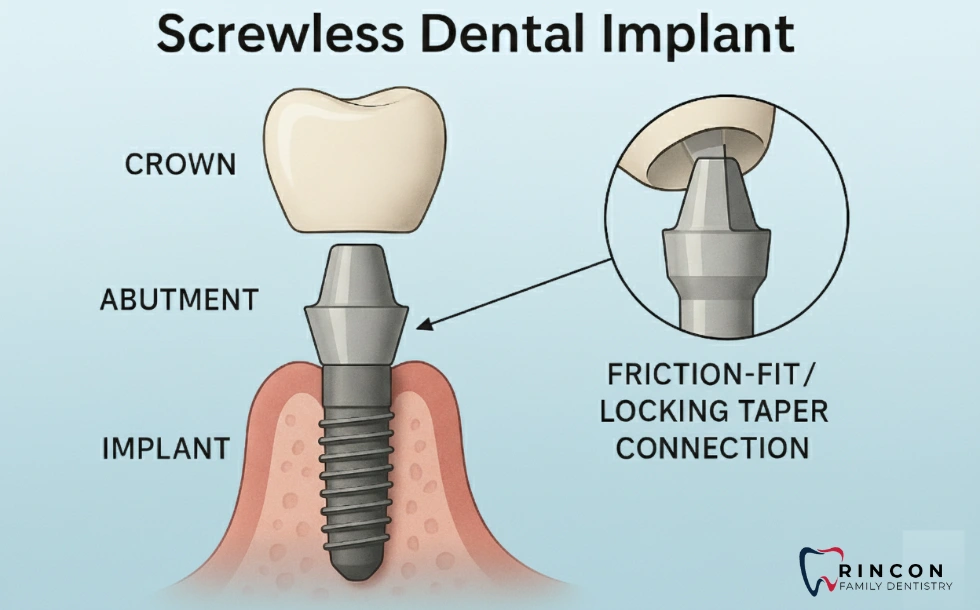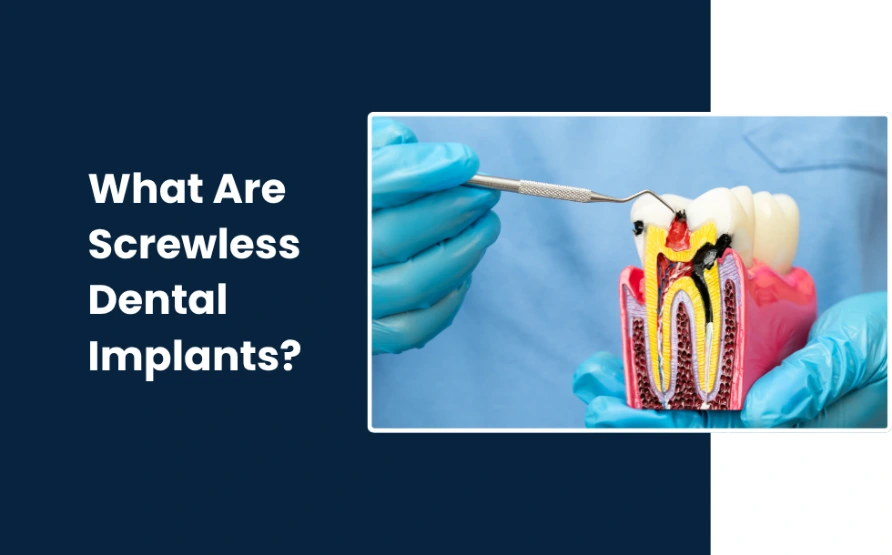Has your dentist recommended implants, but you are hesitant about having metal screws in your mouth? Screwless dental implants offer a modern, natural-looking alternative that eliminates visible screw holes while keeping your smile stable and secure. These systems are designed for patients who want a smoother aesthetic result and a simplified restoration process.
If you have heard terms like cement-retained or friction-fit implants and want to know how they differ from traditional designs, this guide explains their structure, function, and long-term performance.

What Are Screwless Dental Implants?
Screwless dental implants, also called non-screw or cement-retained implants, replace missing teeth without using visible screw access holes. In this design, the crown is bonded or friction-fitted to the abutment instead of being fastened with a screw.
They are commonly used in front teeth or visible smile zones where appearance matters most. Because the crown surface remains uninterrupted, the restoration looks more natural and blends smoothly with the surrounding enamel.
Screwless systems were developed to address aesthetic limitations and occasional screw-loosening problems seen in conventional implants. Let’s look at how these advanced connections work.
How Screwless Dental Implants Work
The screwless abutment system eliminates the visible screw connection between the crown and implant base. Instead, it relies on cement or friction-fit mechanisms that hold the components together securely. These designs enhance comfort and protect the surrounding gum tissue by reducing micro-movement at the connection point.

Cement-retained Implants
Just like the traditional method, an artificial tooth root is placed surgically into your jawbone. Once it is healed, the crown is cemented on top of the abutment. It creates a secure, seamless finish for your new tooth with no visible screw holes.
These are a popular choice among individuals with missing teeth because they offer excellent aesthetics, as it has no screw holes on the crown. However, it should be done by an experienced professional, as any leftover cement can trigger an inflammatory response, causing procedure failure.
Friction-fit Dental Implant System
This is a more advanced design of screwless implants that neither uses a screw nor a strong adhesive. One common design is a conical connection, where the abutment fits snugly into the artificial tooth post, forming a tight, durable seal that keeps it secure and stable.
The Morse taper connection is a well-known version of this design. It locks parts together so that they almost fuse, ensuring a long-lasting bond. It is one of the most reliable types of these artificial tooth systems.
Tapered and press-fit connections also use a snug, screw-free fit that locks the crown securely without movement. All these designs create stability through friction and stop the artificial teeth from rotating, giving strong, stable, and natural-looking teeth for years.
Among all design options, conical connection implants are considered the best. Their tapered, screwless design causes less marginal bone loss, forms a tight, bacteria-resistant seal that prevents infection and enhances long-term stability, making them a top choice for both strength and aesthetics.
One-Piece Implants
Some screwless implants are made as a single piece, where the implant body and abutment are combined. This one-piece structure minimises weak points and shortens treatment time, though it requires accurate placement since angle adjustments are limited.
Benefits and Risks of Screwless Dental Implants
Every dental solution comes with strengths and limitations. Understanding both sides helps patients make informed decisions and set realistic expectations for results and maintenance.
Benefits
- Enhanced appearance with no screw access holes
- Comfortable fit with excellent stability
- Reduced screw-related issues such as loosening
- Hygienic margins that limit plaque buildup
- Proper bite alignment for comfort and natural feel
Studies show that when placed by skilled and professional dentists, screwless implants perform as well as traditional systems. With proper care, they can last 10 to 15 years or longer.
Drawbacks
- Cement-retained crowns can be difficult to remove for repair or replacement
- Any bonding material left under the gums can irritate tissues or cause infection
- Not ideal for heavy grinders, patients with limited bone volume, or those who need frequent adjustments
Understanding these trade-offs helps patients and dentists decide which implant type offers the best long-term outcome.
Maintenance and Longevity
Consistent oral care is vital to the long-term success of screwless dental implants. These restorations function like natural teeth and benefit from the same daily hygiene habits.
Brush and floss daily, paying close attention to the gumline. Professional cleanings help remove residue that home care can miss. Because these systems depend on tight connections, regular checkups allow your dentist to verify stability and ensure no hidden cement remains. With good oral hygiene and periodic monitoring, screwless implants can function reliably for over a decade.
Cost and Affordability of Screwless Dental Implants
The cost of screwless dental implants varies depending on the connection type, materials, and clinical expertise involved. Patients often find the pricing comparable to standard screw-retained systems.
On average, a single implant restoration ranges from three to five thousand dollars per tooth, similar to screw-retained designs.
Are Screwless Implants Cheaper?
They are usually priced about the same because both use titanium fixtures and comparable prosthetic components. Friction-fit systems may cost slightly more due to their precision design, but the difference is minimal compared to the total treatment value. The final price also depends on bone grafting needs, abutment customisation, and lab work involved in creating the crown.
Screwless vs. Screw-Retained Dental Implants
Both designs are reliable and widely used in restorative dentistry. Their main difference lies in how the crown attaches to the abutment and how easily it can be removed for maintenance.
| Feature | Screwless (Cemented or Friction) | Screw-Retained |
|---|---|---|
| Appearance | No screw access hole | Visible access hole |
| Retrievability | Difficult to remove | Easily retrievable |
| Risk of Loosening | Very low | Moderate |
| Risk of Cement Residue | Possible | None |
| Best For | Aesthetic front teeth | Back teeth or retrievable prosthetics |
Your dentist’s choice depends on bone density, bite force, and the restoration’s location in your mouth.
Who Is a Good Candidate for Screwless Implants
Screwless systems are best for patients seeking a clean, natural finish with minimal hardware exposure. Ideal candidates are those with healthy gums, adequate bone density, and a focus on front-tooth aesthetics.
- Healthy gums with no active gum disease
- Adequate jawbone volume to support the implant
- Desire for a screw-free, aesthetic appearance
- Regular commitment to dental hygiene visits
When Screw-Retained Implants Are Better
Patients who grind teeth heavily, have limited bone support, or need easily removable crowns often do better with traditional screw-retained designs. A complete dental evaluation with imaging and bite analysis helps determine which approach fits your case.
Related Guides:
- Types of Dental Implants
- Cost of Mini Dental Implants
- How Long a Dental Implant Takes to Heal and Fully Recover
FAQs About Screwless Dental Implants
Here are quick answers to common questions people ask before choosing this type of implant restoration.
Can screwless implants be removed?
Yes, but removal requires special tools and must be performed by an experienced dentist to protect surrounding tissues.
Are screwless dental implants safe?
They have been proven safe in clinical studies when placed and maintained correctly.
How long do screwless implants last?
With consistent hygiene and regular checkups, they can last more than ten years, often as long as screw-retained implants.
Are screwless dental implants painful?
The procedure is performed under local anaesthesia and generally causes minimal discomfort during recovery.
Final Thoughts
Screwless dental implants offer a refined, screw-free alternative for patients who value aesthetics and comfort. Their friction-fit and cement-retained systems provide lasting strength with a natural finish, though proper placement and maintenance are key to long-term success.
If you’re exploring implant options, discuss both screwless and screw-retained systems with your dentist to determine which best supports your smile, bite, and overall oral health.

